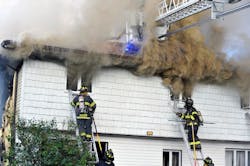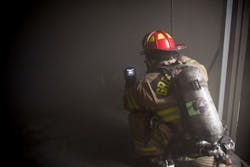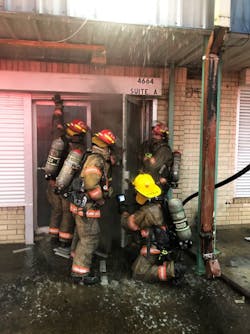When brainstorming a topic for this piece, I was rather sure that search was what I wanted to cover. However, so many variables exist that I couldn’t nail down a specific topic to discuss under the search umbrella. I didn’t want to be too general, but I didn’t want to be too specific either. A tragic fire in the first due of my firehouse and the efforts of my fellow firefighters gave me my answer.
The story of this fire is a terrible one: four victims removed; unfortunately, three lost their life. I wasn’t on scene, but in talking to those who were, including my battalion chief, and reviewing the images, video and stories from the fire, a clear picture emerged of the men and women of the Buffalo, NY, Fire Department (BFD) truly going above and beyond.
The 360 and PPE
At about 3:30 a.m., the BFD was notified of a structure fire with people trapped. The address was only a couple of blocks away from the firehouse, so the crews were on scene quickly.
They arrived to fire in the C/D corner, with at least one victim presenting at the second floor window on the D side of the house. The crew from the truck quickly laddered the building to rescue the woman.
This is a stark and simple reminder of the importance of the 360 size-up at fires. It’s critical for companies that are assigned to search as well as for those who are assigned to suppression. The 360 helps to locate obvious victims as well as obstacles and secondary means of egress. This can be crucial when fire conditions change during rescue efforts, forcing you to go out a different way than you went in.
The victim in the window didn’t have a lot of time before the fire would overwhelm her, which leads to the second area that I want to cover: PPE, its use and donning it.
As a company officer, nothing bothers me more than members who don’t wear their gear properly. Far too often, I see waistbelts not fastened and hoods worn improperly, but what gets me the most is the length of time that it takes some to don their gear properly.
All of us trained during probie school and/or Firefighter I to don and doff gear quickly and properly, but it seems that some members just become complacent and don’t practice anymore after that.
I believe that you should be able to properly don your mask and hood with a gloved hand inside of 30 seconds. This is a business where seconds count.
Luckily for the victim at the window, the firefighter who came for her was proficient at donning his gear and was able to make a difference because of it.
TICs and hand tools
With the 360 completed and obvious victims removed, it was time to work on the occupants who were left in the structure. With reports of victims in the attic, crews began to set up ground ladders for VES while other crews made their way into the structure for search.
In our city, most houses have a staircase, usually in the rear, that provides access to all of the areas, basement-to-attic, so, when conditions allow, we often can get to those upper areas quickly.
There always is debate about where to start, when to stop and are the reports of victims real—and almost every fire has people who claim that occupants are inside. The fire this night had 100 percent confirmation that victims still were inside, and the debate on when to quit was instantly over. Members weren’t going to stop until the victims were out.
Communication among crews and search teams is paramount, so search efforts are maximized. Before we search an area twice, we make sure that all areas are searched once.Communications don’t have to be complicated: left or right, upstairs or down, etc. You should check the room and fire conditions and floors in the rooms from the threshold before you just charge in headlong. You want aggressive searches, but you don’t want kamikaze missions.
Stay low and look. If you are issued thermal imaging cameras (TICs), use them to your advantage. The TIC is a very underutilized tool in my opinion.
If you’re unfamiliar with the types of TICs and the best tactics for their use, plenty of great resources are available to help.
On my rig, we carry a Flir K2 situational awareness TIC to go with the Flir K55s that all of the truck company officers are issued. The situational awareness TICs are carried by the firefighters on the rig to assist them with orientation and search. They are a reasonably priced option for crews if funding for them can be secured.
If you have TICs and use them properly, stay in close voice contact with each other and control doors, when possible, which really sets you up for success during searches.
As with everything on the fireground, conditions dictate tactics, including how much distance that you can allow between members of the search team.
At the fire that inspired this article, the conditions were bad, and emotions were high.
Search crews, particularly those who are assigned to truck companies, should have some type of hand tool with them. There are different opinions on how to use that tool to aid in search: What we learn in training and what applies to real-life situations isn’t always the same. For example, many teach to use the tool as an extension of one’s hand for more reach. I believe that this is fine, in theory, but in most residential structure fires, when searching bedrooms, you will spend so much time wondering what the tool contacted that it will slow your search to a crawl.
I prefer to use the tool as an extension of the wall. I want to use my hands to make contact with what I am searching for, because it should be much easier to figure out whether that object that you hit is a stuffed animal or a human being.
It takes practice to become proficient using this technique, because it, too, can slow you down if you constantly struggle to maintain wall and foot contact with the tool. Drilling is the best remedy for this. In smaller rooms, as so many residential bedrooms are, one person can conduct the search, and, often, you won’t need the tool to extend your reach. In these rooms, the other member of the search team can stay near the door to maintain orientation, continuously monitor conditions, and relay any changes to his or her partner.
Another important thing to practice and drill on is good search posture. Far too often in training or drills, we see firefighters down on all fours, head down, crawling along the wall. In my opinion, this is poor search technique and can hamper versus enhance search efforts.
A good search posture involves the front leg forward, weight to the back leg and head up, so you can “see” what you are heading into. This “tripod technique” also can help you to locate holes in the floor, so you don’t take the express elevator to the floor below.Victim removal
Proper search techniques, posture and communications will lead you to perform better searches and, ultimately, to save lives. They also lead to better situational awareness within structures, which helps you to locate secondary means of egress, to allow you to choose the best method of removal once you find victims.
Removal of fire victims often is a bigger challenge than is finding them. The decision as to the most effective and safest method for removing and yourself from the fire is difficult to make, but it must be made in a split second, and once you make it, you should get on the radio and announce your intention, so resources can be deployed to that area.
The technique that you use to remove victims is another issue. Do you grab and go? Do you need to use some type of assistance device? Are the stairs viable, or do you have to use ground or aerial ladders? The victims’ condition and location sometimes make the decision for you.
You should understand the difficulty of grab-and-go rescues, particularly when victims have been in an area of high heat. I carry an Anderson multiloop rescue strap in my turnout coat radio pocket. It’s an invaluable tool for rescuing victims or one of our own. A personal rope or a piece of tubular webbing can help to do the same thing in a pinch.
Ladder rescues are another animal. The night in question here, two victims were removed from the attic via ground ladder and a third from the second floor via ground ladder.
Ladder rescues are a tremendous physical challenge. Furthermore, they require coordination with outside teams, to ensure that ladders are at the window if you didn’t enter the room through the window. Even departments that have adequate staffing sometimes have difficulty getting ladders to every egress window. Unfortunately, adequate staffing is the exception not the rule in the fire service, so the window that’s the closest to a victim might not have a ladder to it.
Certainly, an aerial can help, assuming that you can get the aerial into position near the egress point.
Make a difference
Good search techniques require practice. They take time to refine. That night in Buffalo, our people went above and beyond to rescue the family. The outcome wasn’t what we wanted, but the crews did their job and gave those people a chance.
Use the resources that are available to you, such as Firefighter Rescue Survey, to learn about other rescues around the country. Learn your district. Know your buildings. It’s your duty. It’s the least that you can do for the citizens who you serve.
About the Author

Sean Eagen
Sean Eagen is a 28-year veteran of the Buffalo, NY, Fire Department. He currently is the captain of Truck 4. Eagen also is an instructor for the New York State Office of Fire Prevention and Control Special Operations Branch. He was a regular presenter at Firehouse's conferences.


